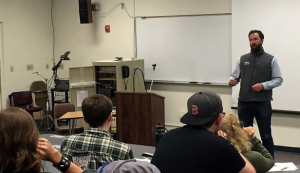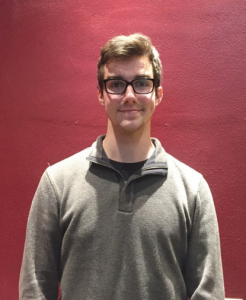
May 1, 2017 | News |
By Jessica McKenna, Contributing Writer

Lucas St.Clair speaks at UMF about developing Katahdin Woods and Water National Monument. (Photo by Jessica McKenna)
Students, faculty, and community members slowly trickled into the C-23 auditorium in Roberts recently to learn first-hand the story of how Katahdin Woods and Water National Monument became a reality from speaker Lucas St. Clair, son of well-known Burt’s Bees co-founder Roxanne Quimby. St. Clair’s family donated the 87,500 acres comprising the monument which was officially designated by President Obama last summer, following a lengthy local debate over the issue. St. Clair used his time to explain the long road leading up to their recent success.
The room went completely dark with the only light coming from the projector screen, a small kerosene lamp was lit and brought the audience from day to night as they witnessed a journey through Katahdin Woods and Water National Monument. The lights came up and Lucas St. Clair stood before the audience in a blue checkered dress shirt and jeans that were worn around the pockets outlining his wallet and phone. He wasted no time jumping into his family’s history and stories of growing up in a hand built log cabin with no water or electricity in Dover-Foxcroft. His mother and father moved from the West Coast to Maine in the 1950s buying 60 acres of land in Piscataquis County classifying themselves as “hippies”.
While attending Gould Academy in Bethel, St. Clair found his passion for the outdoors. “I spent more time outside than in the classroom,” he said. This passion lead him to hike the Appalachian Trail. While hiking through the 100-mile wilderness in Maine, St. Clair found that the long stretch from Baxter State Park to Monson was not truly wild. The family decided to start a plan to protect and preserve the natural beauty of the Maine woods.
Fear and anxiety swept through Maine’s small towns when a proposed map of the park was released to the public. In 2001 Roxanne Quimby had a meeting to discuss the park with Governor Angus King on Sept 11. The meeting was cut short due to the terrorist attacks and Quimby took that as a sign to put the park on hold. After selling Burt’s Bee’s she started mapping out a revised version of the proposed park. Yet again she was met with opposition when local newspapers labeled her as an out-of-stater bad mouthing Maine on a national level. This was the last straw and Quimby turned the fight over to her son Lucas with a deadline of the 100th anniversary of the National Parks Service.
St. Clair spent his time talking to locals and compiling reports about Maine recreation and the economics of surrounding towns. “I basically camped out in the Katahdin region for four years,” said St. Clair, explaining his efforts to talk to people and gather support for the project. Through these informal talks St. Clair found out the wants and needs of the towns and its people and that of the Native American tribes in the area. A bill was drafted for the park but failed in the legislature.
St. Clair turned his sights towards the Obama Administration and asked for help through the use of the Antiquities Act to establish the park. A five-hour public meeting was held in Orono with 1,400 in attendance. “I had many people poking their fingers in my chest telling me I was ruining their community,” said St. Clair. The meeting concluded with the majority being in support of the park with only 12 of the 450 comment cards opposing.
The White House and St. Clair then entered the legal minefield of right-of-way and liability issues that accompanied the donation of the land to the government. The park was finally established and is the only national park that allows hunting, truly catering to the Maine communities that surround it.
Professor Linda Beck, who organized the talk with St. Clair, attended with her Environmental Politics class and said, “Some (students) were actually quite surprised, they had anticipated not liking or agreeing with him but found his presentation and story quite compelling.”
Throughout the talk laptop keys were clicking at rapid fire and pages of notepads were filled as quickly as they could be turned. Students and professors struggled to record the enthralling story. Professor Wendy Harper attended the talk with her Environmental & Resource Economics class and was pleased with how St. Clair’s story could influence her students. “I think students always benefit when they hear from folks who make things happen,” she said, “particularly those who “learn by doing” and have a great passion for their work.”
In recent news, while establishment of the park was secured under the Obama administration’s use of the Antiquities Act, according to a report from the Portland Press Herald, there is a possibility that the designation could be reviewed by the Trump administration along with a list other monuments. While there were conflicting comments from the Department of the Interior regarding whether or not the Katahdin monument is on this list, St. Clair says that he is confident that the project would stand on its own merits even if reviewed.

Apr 20, 2017 | Feature |
By Jessica McKenna, Contributing Writer

Artist Shane Cynewski stands next one of the sculptures from his body of work “Investigating Undesirability Through the Unmonumental.” (Photos by Jessica McKenna)
A semester’s worth of hard work came to an end on April 13th with the opening of the Senior Art students’ Thesis Exhibition, “Five to Nine.” The sun slowly disappeared from the sky over the UMF campus casting a faint blue shadow as four of UMF’s Senior artists made their way down the tarred pathway to the small art gallery near the green. The artist entered the compact gallery where their names were printed on the wall brightly lit by a spotlight for all to see. Each floor was a mixture of different artists creations using various media to convey their work.
For Senior artist Gabrielle Ganiere the exhibition signals an end to her journey at UMF. “This is my last big thing,” said Ganiere. “I do have a symposium talk about my artistic process but this is the pivotal moment.”
Ganiere’s work stood out amongst her peers as her media consisted of pantyhose, trash bags, yarn and other fabrics that brought a softer tone to the exhibition. Each piece embodied a creature of sorts with some invoking memories of childhood stuffed animals or beloved pets, while others made spectators think twice before they took a step closer. “I want them to be confused on how they feel,” said Ganiere, “Do they want to get close or stay away, I like to see people’s expectations of each piece.”
A pink mattress laid against a wall with plastic milk jugs, a wooden chair, and a blond wig attached to the once familiar object. Artist Shane Cynewski’s body of work made spectators feel as though they had entered a home but the everyday items they encountered had changed.
“I used sculpture as my media and domestic objects, so items you could find in a home,” said Cynewski. “The reason I use those objects is I try to inverse the desirability of them.”
Each sculpture turned household items into unknown objects to the viewer with a changed purpose. Cynewski and his classmates had been preparing for the show since the fall of 2016 starting with senior seminar. “We wrote our thesis in the fall and then started working on our body of work,” said Cynewski. Each Senior spent their spring semester finishing their body of work, participating in faculty critiques every few weeks and writing press releases and artist statements.
As the crowd grew larger the artists were surrounded by friends, family, and professors sharing words of congratulations and acknowledgments of a job well done. Spectators moved from piece to piece at a glacial pace taking in as much as they could trying not to miss any part of the artist’s message. UMF President Kathryn Foster spoke with an artist in the middle of the Emery Community Arts Center flex space, and followed her to a piece of work to delve into the meaning and the artist’s process. “It’s thrilling to see the culmination of so much thought, hard work, and creativity!” said Foster.
The exhibition continues through May 13 in both the UMF Art Gallery and the Emery Community Arts Center showcasing the works of the six senior UMF artists.

Feb 17, 2017 | News |
By Jessica McKenna, Contributing Writer

Newly elected senator Sam O’Neal. (Photo by Jessica McKenna)
The UMF Student Senate held a special election at a recent weekly meeting to fill the general assembly seat that has been vacant since the beginning of the spring semester
The election was held during a normal senate meeting and any student who paid the student activity fee was welcomed to run. The senate is comprised of 19 general assembly seats and 6 executive board members, but coming into the spring semester due to a student transfer a seat on the general assembly became vacant. Sam O’Neal was the only candidate who ran and was voted in by a unanimous ballot with 21 members of senate voting yes.
O’Neal a Computer Science major, in his junior year, was given a chance to speak to the members of the senate on why he wanted the position. “I’m part of the computer club and I would like to represent them,” said O’Neal “I want to be more involved on campus and to not only be involved in one club but the entire process.”
Many members of senate welcomed O’Neal Monday night as he joined his fellow senators for the remainder of the meeting. The new senator voted on four proposals brought before senate after his election. Student Senate Secretary Meagan O’Reilly was pleased to finally have a full senate again. “It has been hard because the senator that left was very active in committees and provoked discussion during meetings.”
Senator Matt Lulofs, a two-year veteran of the senate, said that this election was very beneficial to the senate. “We will have another mind when voting and getting information out there,” he said, “it’s always helpful to have new faces and opinions when deciding on issues.”
O’Neal said he will spend the spring semester familiarizing himself with senate procedures and the upcoming budgets process. The new senator has the opportunity to fill open seats on two committees but no positions were appointed at the weekly meeting.
All senators are required to hold two office hours per week, to discuss student questions and club matters. Lulofs said, “The most important part of being a senator is being fair to everyone and to not be biased and just focus on your own interests.”
With only half the school year remaining and elections coming next fall O’Neal said: “I would like to run again in the fall because so far it has been an incredible experience.” All senators will be up for reelection in the fall and will be voted in by the student body.
The Student Senate has a full schedule for the rest of the semester with club budgets being reviewed, Spring Fling, The Leadership Banquet, and various proposals being submitted.



